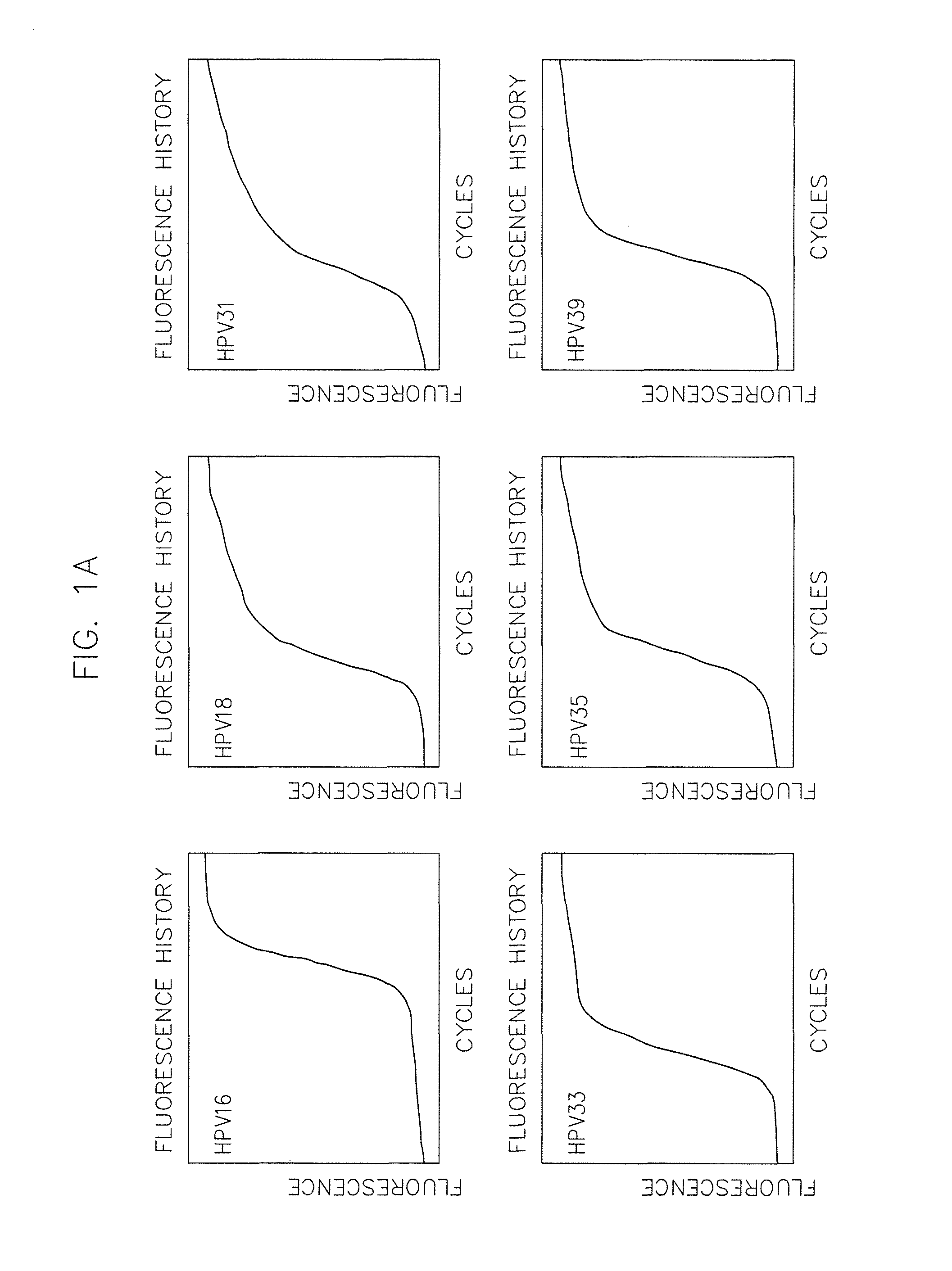Method of simultaneous detection and typing of human papilloma viruses
a technology detection method, which is applied in the field of human papilloma virus detection, can solve the problems of low sensitivity and specificity of hpv detection methods, high cost of screening programs, and increased risk of developing severe dysplasia leading to cervical cancer
- Summary
- Abstract
- Description
- Claims
- Application Information
AI Technical Summary
Benefits of technology
Problems solved by technology
Method used
Image
Examples
example 1
Development and Testing of Primers
[0083]DNA Template. Plasmids containing HPV16, -18, -31, -33, -35, -39, -45, -51,-52, -56, -58, -59, -68, -73, and -82 were collected from a variety of sources including from PCR products of detection targets generated by overlapping PCR. Where no target was available, a unique target was determined based on genomic sequence (e.g. 120 bp long). Then two overlapping primers (e.g. 80 bases each that contains 60 unique bases and 20 overlapping bases each) were created and PCR was performed. Then the PCR product from each reaction was mixed together and PCR was performed with a regular primer (e.g. 20 bases) to obtain the full length target.
[0084]The copy numbers for individual template was determined by measuring the concentration using PicoGreen dye (Invitrogen, Carlsbad, Calif.).
[0085]Real-time PCR. The PCR amplification was performed in a 20-μl volume containing 1× MasterMix (Roche Diagnostics, Indianapolis, Ind.) with a 200 nM concentration of each...
example 2
Determination of HPV Presence and Type in Laboratory Samples
[0086]Materials and Methods—Complete Care HPV Panel
[0087]a) Preparation of assay mixes and controls:[0088]a. Assay mixes are made to the required amounts of primers and probes for a given total quantity of assay mix. Concentrations of primers and probes are equal for each HPV type (i.e. 2.5 microM each of HPV 16 forward primer, reverse primer, and probe). Final concentrations of each HPV type are as follows:[0089]i. A-Mix—2.5 microM of primers and probes for HPV 31, 33, 59 and 5 microM of primers and probes for HPV 35.[0090]ii. B-Mix—2.5 microM of primers and probes for HPV 18, 51, 56 and 3 microM primers and probes for HPV 16 and 5 microM primers and probes for HPV 82.[0091]iii. C-Mix—2.5 microM of primers and probes for HPV 16, 52, 73 and 5 microM of primers and probes for HPV 45.[0092]iv. D-Mix—2.5 microM of primers and probes for HPV 39, 68 and 1.25 microM primers and probes for beta-globin and 5 microM primers and prob...
example 3
Dynamic Range of Detection
[0209]This example illustrates the dynamic range of detection of HPV for a method of HPV detection of the present teachings and establishment of a standard curve for HPV detection.
[0210]In this example, standard curves, as shown in FIG. 3, for measuring HPV quantity were determined for 10-fold serial dilutions over a 107-101 gene copy range, of an HPV sample of known initial concentration. The samples were subjected to real time PCR amplification of a target sequence, and the quantity of amplified DNA was measured using a PicoGreen (Molecular Probes) assay. The gene copy number was then calculated using the length and mass of the amplified DNA. For these calculations, the target gene was presumed present in one copy per HPV genome. The results showed that the assay was sensitive to 10 HPV genomic equivalents per reaction at 40 PCR cycles.
PUM
| Property | Measurement | Unit |
|---|---|---|
| wavelengths | aaaaa | aaaaa |
| wavelengths | aaaaa | aaaaa |
| wavelengths | aaaaa | aaaaa |
Abstract
Description
Claims
Application Information
 Login to View More
Login to View More - R&D
- Intellectual Property
- Life Sciences
- Materials
- Tech Scout
- Unparalleled Data Quality
- Higher Quality Content
- 60% Fewer Hallucinations
Browse by: Latest US Patents, China's latest patents, Technical Efficacy Thesaurus, Application Domain, Technology Topic, Popular Technical Reports.
© 2025 PatSnap. All rights reserved.Legal|Privacy policy|Modern Slavery Act Transparency Statement|Sitemap|About US| Contact US: help@patsnap.com



